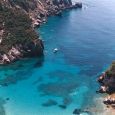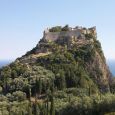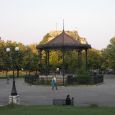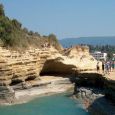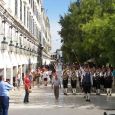Corfu
Advertisement
By Air
The Ioannis Kapodistrias International Airport, named after Ioannis Kapodistrias a distinguished Corfiot and European diplomat and the first governor of the independent Greek state is located around three kilometres south of Kerkyra, just half a kilometre north of Pontikonisi.The approach and landing in a northeasterly direction afford passengers spectacular aerial views of Pontikonisi and Vlaheraina Monastery, also taking in the hills of Kanoni, as the runway employed for landing lies a few hundred metres from these spectacular local landmarks.The airport offers domestic flights from Olympic Airlines (OA 600, 602 and 606) and Aegean Airlines (A3 402, 404 and 406).Seaplanes, Air Sea Lines, a Greek seaplane operator offers scheduled flights from Corfu to Paxoi, Lefkada, Ithaki, kefalonia, Ioannina, Patras and Brindisi in Italy.
By Bus
The buses to the main places on the island run about six times a day between the city and Glyfada, Sidari, Pleokastritsa, Roda and Acharavi, Lefkimmi, Lefkimmi and Piri. Other coaches drive up to twice a day to Athens and Thessaloniki.City buses run through the city to the Achilleon, Gouvia, Afra, Pelekas and some other places of interest.There are no public buses to the airport.
By Ferry
Corfu has ferry services both by traditional ferries to Gaios in the island of Paxoi and as far as Patras and both traditional ferries and advanced retractable airfoil, hydrodynamic-flow, high-speed ferries called Flying Dolphins to Igoumenitsa and Sarande in neighbouring Albania.The small port of Lefkimmi is also to be found at the southernmost tip of the island on Cape Kavos, offering a ferry service to the mainland.
By Road
The island is linked by two motorways, GR-24 in the northwest and GR-25 in the south.Greek National Road 24, Cen., NW, Corfu – Palaiokastritsa and Greek National Road 25, Cen., S, SE, Corfu – Lefkimi.
Advertisement
Archaeological Museum of Corfu
The museum land was donated by the city of Corfu.Its initial purpose was to house the archaeological finds from the Temple of Artemis in Corfu.In 1994 it was expanded with the addition of two more exhibit halls that display the more recent finds at the ancient citadel of Corfu.It is located on 1 Vraila Armeni St.On 15 October 2010, the museum closed for works with no reopening date yet announced.
Banknote Museum
is a museum located in Corfu, Greece.It showcases an almost complete collection of the Greek currency from 1822 to present about 2000 items.It includes the first treasury bonds issued by the newly liberated Greek State in 1822 until the replacement of the drachma by the euro in 2002.It also includes sketches essays and printing plates of Greek banknotes.One of its rarest holdings is the 1860 "colonata".The museum was established in 1981 by the Ionian Bank and it is housed at the former Ionian Bank building designed by Corfiote architect Ioannis Chronis in about 1840.In 2000 Ionian Bank merged with Alpha Bank and subsequently the Banknote Museum was renovated and was reopened in 2005.An additional exhibit hall was added showcasing "Ionian Bank Limited" which was a British venture and the first bank to operate in Greek territory.The museum collection is considered one of the most complete of its kind in the world.Among the museum exhibits are some rare specimens of Greek currency.Exhibits include the first banknotes issued by first Governor of Greece Ioannis Kapodistrias.The Kapodistrias notes are simple and feature a rose coloured Phoenix on white background.The museum collection also contains the pre-Kapodistrian treasury bonds issued by the provisional Greek government in "pisters" or "grossia".
Castle of Angels
is one of the most important Byzantine castles of Greece.It is located on the island of Corfu at the top of the highest peak of the island's shoreline in the northwest coast near Palaiokastritsa ("Old castle place") and built on particularly steep and rocky terrain.The origin of its name is not completely clear, with some historians mentioning that in 1214 Michael I Komnenos Doukas, Despot of Epirus, sometimes called Michael Angelos, annexed Corfu to Epirus and following his death, Michael II Komnenos Doukas, often called Michael Angelos in narrative sources, further fortified the area and named it after himself and his fatherAngelokastro.The Despots were related to the Komnenoi dynasty of Byzantine emperors.Today foreign language tourist signs in the area refer to it, wrongly, as St. Angelo's castle.Angelokastro is one of the most important fortified complexes of Byzantine Corfu. It forms an Acropolis, translated as city on the edge, that surveyed the region all the way to the southern Adriatic and therefore presented a formidable strategic vantage point to the occupant of the castle.The engineering of its construction at such a remote and forbidding location is remarkable by any standards, not only medieval.
Municipal Theatre of Corfu
was τhe main theatre and opera house in Corfu, Greece, from 1902 to 1943.The theatre was the successor of the Nobile Teatro di San Giacomo di Corfu, which became the Corfu city hall.It was destroyed during a Luftwaffe aerial bombardment in 1943.During its 41 year history it was one of the premier theatres and opera houses in Europe with contributions to the Arts and to the history of the Balkans.The Municipal theatre was built to accommodate the demands of a growing audience.The decision for its construction was taken in 1885, during the mayoralty of Georgios Theotokis, and construction started in 1893 by mayor Michael Theotokis.High construction costs delayed its inaugural opening until 1902.The architect was the Italian Conrado Pergolesi who developed plans modelled after La Scala in Milan.The maximum height of the theatre was 39 meters; there was a gallery at the front entrance adorned by high columns of the Tuscan order.The entrance featured large purple columns and its high walls were decorated with frescoes of famous composers created by Italian artists.The upper floor was decorated by four Corinthian order semi-columns and a gable.The official emblem shield of Corfu stood in relief at the centre of the gable surrounded by a laurel wreath.
The Noble Theatre of Saint James of Corfu
was a theatre in Corfu, Greece which became the centre of Greek opera between 1733 and 1893.Despite its provincial origins it attracted Italian musicians and composers, many of whom became permanent residents of Corfu and contributed to the local music scene.The theatre acted as a catalyst in this cultural interaction and gave impetus to the development of the Ionian School of Music.Corfiot composer Nikolaos Halikiopoulos Mantzaros was a beneficiary of the synergy between the Italian and Corfiot musical traditions.The musical tradition established by the theatre is especially important to the history of modern Greek music since it helped establish a Greek musical presence at a time when the Greek State did not even exist.The theatre staged the type of comic opera known as opera buffa which was less elaborate and therefore more economical than the full fledged opera seria.San Giacomo's opera crews were mainly from southern Italy.The opera house functioned during times of upheaval unabated as, for example, during the arrival of the French in 1797.In 1799, during the Russia-Ottoman siege, the theatre continued its performances even as the foreign opera troupe was unable to leave the island due to the blockade.The performance at such a challenging time was used as a means for propaganda and to raise the morale of the population.
Achilleion palace
is a palace built in Corfu by Empress of Austria Elisabeth of Bavaria, also known as Sissi after a suggestion by Austrian Consul Alexander von Watzberg.Sissi was a woman obsessed with beauty and very powerful but tragically vulnerable since the loss of her only son, Crown Prince Rudolf of Austria in the Mayerling affair in 1889.A year later in 1890 she built a summer palace in the region of Gastouri, now the municipality of Achilleion, about ten kilometres to the south of the city of Corfu.The palace was designed with the mythical hero Achilles as its central theme.
May - August
December - February
Information not available
Advertisement

